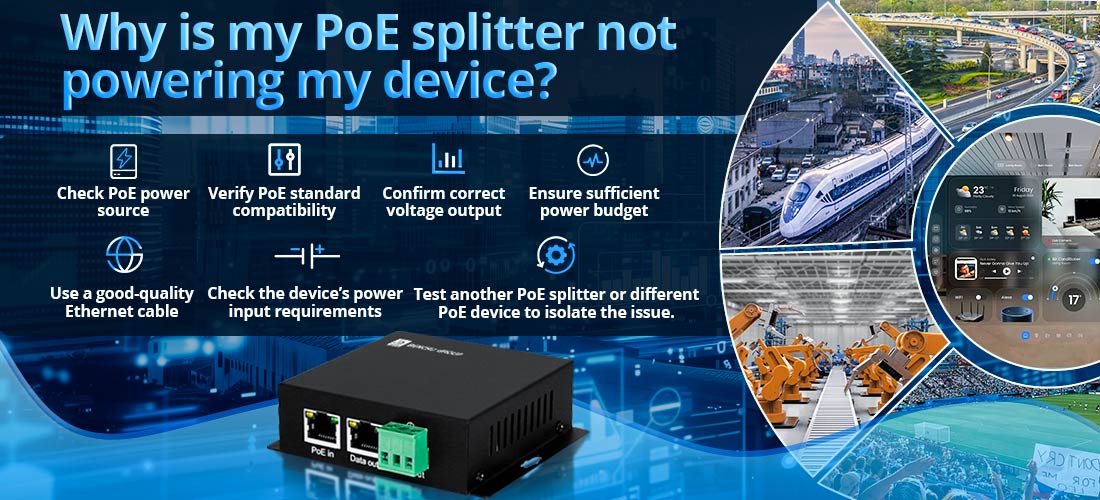
إذا لم يتم تشغيل فاصل Poe الخاص بك ، فقد تسبب عدة عوامل في هذه المشكلة. فيما يلي دليل استكشاف الأخطاء وإصلاحها مفصلة للمساعدة في تشخيص المشكلة وحلها.
1. الوظيفة الأساسية لبرز
A بوي فاصل يأخذ إدخال PoE (كابل Ethernet مع الطاقة والبيانات) ويفصله إلى:
--- إخراج Ethernet للبيانات فقط (RJ45) للاتصال بجهاز غير بوي.
--- إخراج الطاقة (عادة ما يكون العاصمة ، مثل 5V ، 9V ، أو 12V) لتشغيل الجهاز.
إذا فشل الخائن في تشغيل جهازك ، فقد تكون المشكلة مرتبطة بالطاقة أو توافق الشبكة أو جودة الكبل أو متطلبات الجهاز.
2.
أ. مشكلات مصدر السلطة
يتطلب فاصل Poe مصدر طاقة يدعم POE ، مثل:
--- مفتاح بو
--- حاقن بو
--- جهاز توجيه يدعم بو أو NVR (للكاميرات الأمنية)
إذا لم يوفر مصدر POE الخاص بك الطاقة بشكل صحيح ، فلن يعمل الفاصل.
يصلح:
1. تأكيد POE المصدر: تأكد من دعم التبديل/الحاقن/جهاز التوجيه POE (802.3AF ، 802.3AT ، أو 802.3BT).
2. تحقق من إخراج POE:
--- 802.3AF (15.4W): يدعم الأجهزة منخفضة الطاقة (على سبيل المثال ، هواتف IP ، بعض الكاميرات).
--- 802.3at (30W ، POE+): مطلوب للأجهزة ذات الطاقة العليا (على سبيل المثال ، كاميرات PTZ ، نقاط الوصول).
--- 802.3BT (60W-100W ، POE ++): مطلوب للأجهزة الشاقة (على سبيل المثال ، المعدات الصناعية).
3. اختبر مع جهاز آخر: قم بتوصيل جهاز متوافق مع POE (على سبيل المثال ، كاميرا PoE أو نقطة الوصول) مباشرة في المفتاح أو الحاقن للتحقق من إخراج الطاقة.
ب. معايير POE غير متوافقة
يجب أن يتطابق Poe Splitters مع معيار POE لمصدر الطاقة. إذا كان هناك عدم تطابق ، فقد لا يتم تسليم السلطة.
يصلح:
--- تحقق مما إذا كان بويتر بويتر يدعم 802.3af أو 802.3at أو 802.3bt.
--- تأكد من حاقن POE أو التبديل يدعم POE النشط (IEEE 802.3AF/AT/BT) بدلاً من POE السلبي (الجهد غير القياسي).
--- إذا كان استخدام نظام POE السلبي ، تأكد من أن الجهد يطابق متطلبات إدخال الفاصل.
ج. إخراج الجهد غير الصحيح
يقوم Poe Splitters بتحويل قوة POE 48V الواردة إلى فولتية أقل مثل 5V أو 9V أو 12V. إذا كان الجهد لا يتطابق مع متطلبات الجهاز ، فلن يتم تشغيله.
يصلح:
--- تحقق من الجهد المطلوب لجهازك والتيار (على سبيل المثال ، لن يعمل جهاز 12V مع خائن 5V).
--- تأكد من إخراج Poe Splitter الجهد الصحيح (قد يكون له مفتاح لتحديد بين الفولتية المختلفة).
--- اختبار إخراج التيار المستمر من الفاصل مع مقياس متعدد للتحقق من الجهد.
تجاوزت ميزانية السلطة
إذا شاركت أجهزة متعددة أ تبديل بو أو الحاقن ، قد يتجاوز إجمالي سحب الطاقة الميزانية المتاحة ، مما يمنع الخائن من استلام الطاقة.
يصلح:
--- حساب إجمالي الطلب على الطاقة لجميع أجهزة POE المتصلة.
--- تحقق من سعة الطاقة/حاقن POE (على سبيل المثال ، يمكن لمفتاح POE 120W أن يعمل فقط على تشغيل عدد محدود من الأجهزة).
--- افصل أجهزة Poe الأخرى واختبار الخائن مرة أخرى.
E. كابل Ethernet معيب أو غير متوافق
يمكن أن يمنع كابل الإيثرنت التالف أو منخفض الجودة الطاقة من الوصول إلى الخائن.
يصلح:
--- استخدم كابل Ethernet CAT5E أو CAT6 أو CAT6A (تجنب الكابلات ذات الدرجة المنخفضة).
--- اختبار مع كابل Ethernet مختلف للتحقق من الضرر.
--- تأكد من أن طول الكبل ضمن نطاق POE القياسي (عادةً 100 متر/328 قدمًا).
F. الجهاز لا يقبل الطاقة من الفاصل
تحتوي بعض الأجهزة على متطلبات إدخال الطاقة الصارمة وقد لا تقبل الطاقة من فاصل POE عام.
يصلح:
--- تحقق مما إذا كان الجهاز يتطلب محول طاقة محدد مع الجهد المنظم (على سبيل المثال ، تتطلب بعض معدات الشبكات محولات خاصة).
--- تتطلب بعض الأجهزة التي تعمل بالطاقة USB PD (توصيل الطاقة) ، والتي لا يقدمها العديد من Poe Splitters.
ج.
يمكن أن يكون المشكلة المعيبة لـ POE أو مفتاح/حاقن POE هي المشكلة.
يصلح:
--- جرب خائن بو مختلف لمعرفة ما إذا كانت القضية مستمرة.
--- اختبر جهازًا آخر يعمل بنظام POE للتحقق مما إذا كان مفتاح/حاقن POE يوفر الطاقة.
--- أعد تشغيل مفتاح/حاقن POE-تحتاج بعض النماذج إلى موانئ Rescan بعد الاتصال.
3. قائمة مراجعة استكشاف الأخطاء وإصلاحها سريعة
--- تحقق من مصدر الطاقة POE (التبديل/الحاقن نشط ويوفر الطاقة).
--- تحقق من توافق POE القياسي (802.3AF ، 802.3at ، 802.3BT).
--- تأكيد إخراج الجهد الصحيح (يجب أن يتطابق الجهاز والفاصل).
--- ضمان ميزانية طاقة كافية (الخائن والجهاز داخل حدود POE Power).
--- استخدم كابل إيثرنت ذو جودة جيدة (CAT5E أو أعلى ، غير متضرر).
--- تحقق من متطلبات إدخال الطاقة للجهاز (تحتاج بعض الأجهزة إلى محول طاقة معين).
--- اختبار فاصل Poe آخر أو جهاز Poe مختلف لعزل المشكلة.
4. الخلاصة
إذا لم يكن تقويم Poe الخاص بك يعمل على تشغيل جهازك ، فإن الأسباب الأكثر ترجيحًا هي معايير POE غير متوافقة ، أو إخراج الجهد غير الصحيح ، أو مزود الطاقة غير الكافي ، أو الكبل/الخائن المعيب. يجب أن يساعدك التحقق من توافق إدخال الطاقة/الإخراج بعناية وكابلات الشبكة في تحديد المشكلة وحلها بكفاءة.